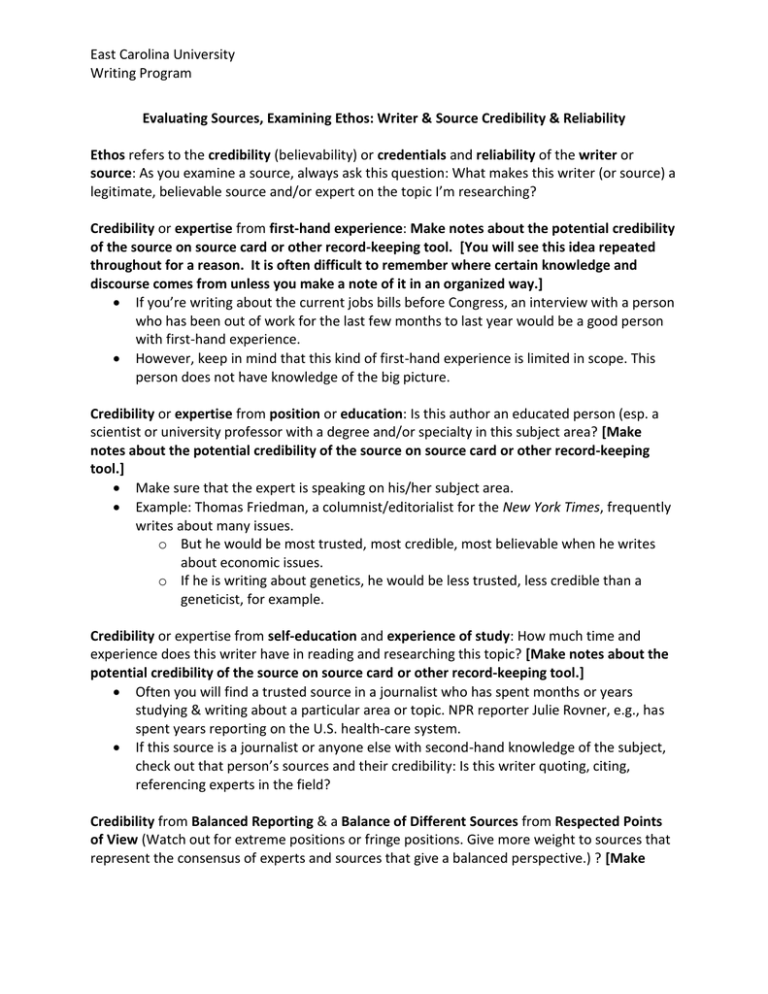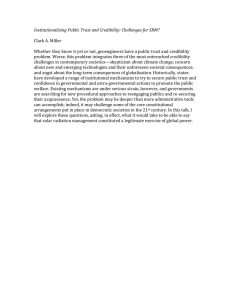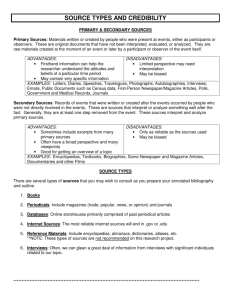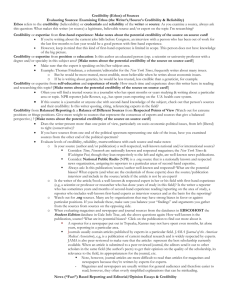Evaluating Sources, Examining Ethos
advertisement

East Carolina University Writing Program Evaluating Sources, Examining Ethos: Writer & Source Credibility & Reliability Ethos refers to the credibility (believability) or credentials and reliability of the writer or source: As you examine a source, always ask this question: What makes this writer (or source) a legitimate, believable source and/or expert on the topic I’m researching? Credibility or expertise from first-hand experience: Make notes about the potential credibility of the source on source card or other record-keeping tool. [You will see this idea repeated throughout for a reason. It is often difficult to remember where certain knowledge and discourse comes from unless you make a note of it in an organized way.] If you’re writing about the current jobs bills before Congress, an interview with a person who has been out of work for the last few months to last year would be a good person with first-hand experience. However, keep in mind that this kind of first-hand experience is limited in scope. This person does not have knowledge of the big picture. Credibility or expertise from position or education: Is this author an educated person (esp. a scientist or university professor with a degree and/or specialty in this subject area? [Make notes about the potential credibility of the source on source card or other record-keeping tool.] Make sure that the expert is speaking on his/her subject area. Example: Thomas Friedman, a columnist/editorialist for the New York Times, frequently writes about many issues. o But he would be most trusted, most credible, most believable when he writes about economic issues. o If he is writing about genetics, he would be less trusted, less credible than a geneticist, for example. Credibility or expertise from self-education and experience of study: How much time and experience does this writer have in reading and researching this topic? [Make notes about the potential credibility of the source on source card or other record-keeping tool.] Often you will find a trusted source in a journalist who has spent months or years studying & writing about a particular area or topic. NPR reporter Julie Rovner, e.g., has spent years reporting on the U.S. health-care system. If this source is a journalist or anyone else with second-hand knowledge of the subject, check out that person’s sources and their credibility: Is this writer quoting, citing, referencing experts in the field? Credibility from Balanced Reporting & a Balance of Different Sources from Respected Points of View (Watch out for extreme positions or fringe positions. Give more weight to sources that represent the consensus of experts and sources that give a balanced perspective.) ? [Make East Carolina University Writing Program notes about the potential credibility of the source on source card or other record-keeping tool.] Does the writer present more than one point of view, particularly on socio-economicpolitical issues, from left (liberal) to right (conservative)? If you have sources from one end of the political spectrum representing one side of the issue, have you examined sources from the other end of the political spectrum? Evaluate levels of credibility, reliability, trustworthiness with each source and make notes: Is your source (author and/or publication) a well-respected, well-known national and/or international source? o Consider: Time, Newsweek are nationally known and respected magazines; the New York Times & Washington Post, though they lean respectively to the left and right, are well-known news publications. o Consider: National Public Radio (NPR) is a .org source that is a nationally known and respected news organization, assigning its reporters to a particular areas of second-hand expertise. o Always ask: Is this publication/source/author well-known and respected? What are the potential biases? What experts (and what are the credentials of those experts) does the source/publication interview and include in the source/article if the article is not by an expert? o Is the writer of the article/book a well-known & respected expert in her or his field with first-hand experience (e.g, a scientist or professor or researcher who has done years of study in this field)? Is the writer a reporter who has sometimes years and months of second-hand experience reading/reporting on the area of study, a reporter who includes well-known first-hand experts as interview sources and as the basis for the reporting? o Watch out for .org sources. Many are by organizations that may have strong biases in favor or against particular positions. If you include these, make sure you balance your “findings” and arguments you gather from the sources from sources on the opposing side. o When evaluating magazines and newspaper and journal sources from the databases in EBSCOHOST the Student Edition database in Gale Info Trac, ask the above questions again: How well known is the publication, source? What are its potential biases? Click on the publication to find out more about it. A reporter for a newspaper put out in Topeaka, Kansas may not have spent even months, let alone years, reporting in a particular area. Journals usually contain articles published by experts in a particular field. JAMA (Journal of the American Medical Association), e.g, is a publication of current medical research and is widely respected by experts. JAMA is also peer-reviewed to make sure that the articles represent the best scholarship East Carolina University Writing Program currently available. When an article is submitted to a peer reviewed journal, the editors send it out to other scholars in the same field (the author's peers) to get their opinion on the quality of the scholarship, its relevance to the field, its appropriateness for the journal, etc. Note, however, journal articles are more difficult to read than articles for magazines and newspapers because they’re written by experts for experts. Magazines and newspapers are usually written for general audiences and therefore easier to read; however, they often overly simplified explanations that can be misleading. News (“Fact”) Based Reporting and Editorial/Opinion Essays & Credibility Non-biased reporting does not exist. Every writer, reporter, or human being has a point of view and perspective and puts “the facts” into a picture or context that makes sense to her or him. You should look for articles, sources, writers presenting more than one perspective and show which perspectives are what the experts in a field of study consider reasonable and probable and which ideas or facts most reasonable people in that field of study agree upon and which ides or facts the experts consider still open to debate. Scientists examine data and evidence observable from our five senses and make hypotheses. o Theories are hypotheses that have the most evidence to support them. o Based on repeated study and/or experimentation, theories are the most probable explanations for phenomena studied. o You should look what is the general agreement of the majority of scientists within a particular field, noting what those experts think is most probable and what those experts think is still questionable. Be aware of when you are reading editorials, opinion essays in periodicals (these writers are sometimes called columnists). o An editorialist or columnist may include “facts” and arguments you will find useful. o However, you must ask these questions: Are these facts and arguments most experts in the field would agree upon? Is the editorialist an expert on this particular topic? Even if the editorialist is not an expert on the topic, does she/he support his or her arguments with facts, ideas, theories with which most experts in that field would agree? Does this columnist cite experts? East Carolina University Writing Program Primary and Secondary Sources Primary sources will include research studies and experimental data on topics one is researching. The conclusion of such reports will provide one with what the experts think the data may mean. You should also seek out reports that consolidate and review research studies, secondary sources that analyze and evaluate primary sources and put those original sources in language you can understand. o When looking at studies and surveys and experiments, consider the following: How many people were involved? Over how long a period? Is the number a statistically significant number? How many studies were conducted? Are the results of the studies consistent or contradictory? o Look for what the consensus of the experts is on the various studies. What do most experts think the data means? o On what do the experts still disagree and why do they disagree?




